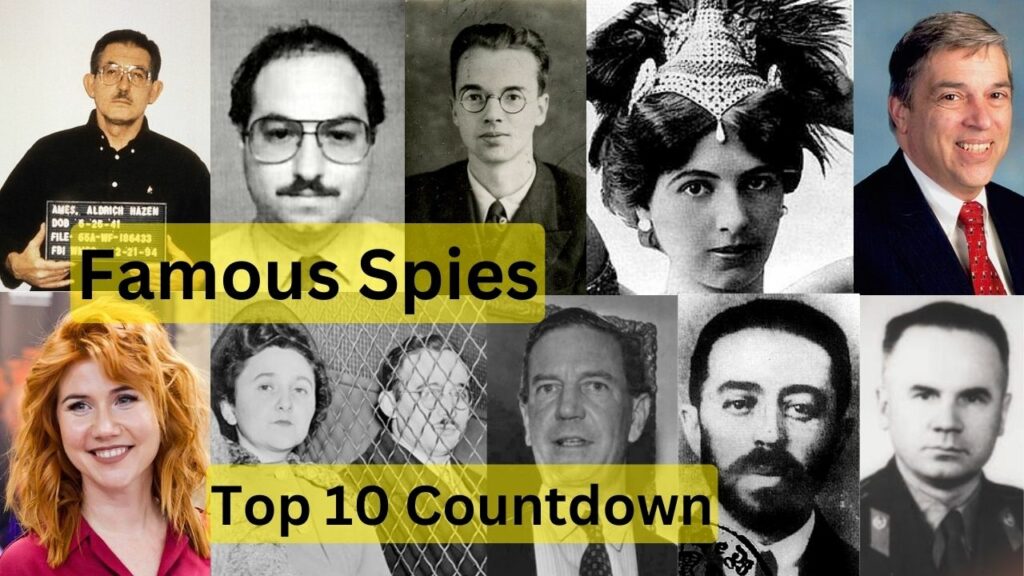
This top 10 countdown is famous spies. For more research, you can access our bibliography of famous spies. Here is an overview of who is on the list:
- Mata Hari: Margaretha Geertruida Zelle, better known as Mata Hari, was a Dutch exotic dancer and courtesan who became a spy for Germany during World War I. She was accused of passing information to German intelligence and was executed by the French in 1917.
- Aldrich Ames: Aldrich Ames was a CIA officer who spied for the Soviet Union and Russia. He provided classified information to the KGB for almost a decade, resulting in the execution of multiple US agents in the Soviet Union.
- Julius and Ethel Rosenberg: Julius and Ethel Rosenberg were American citizens who were convicted and executed for espionage in 1953. They were accused of passing atomic bomb secrets to the Soviet Union during World War II.
- Kim Philby: Kim Philby was a British intelligence officer and a member of the Cambridge Five spy ring that passed information to the Soviet Union during the Cold War. He served as a double agent and worked for the Soviet Union while working for MI6.
- Robert Hanssen: Robert Hanssen was an FBI agent who spied for the Soviet Union and Russia for more than two decades. He provided classified information that compromised US intelligence operations and led to the deaths of several Russian intelligence assets.
- Klaus Fuchs: Klaus Fuchs was a German-born physicist who spied for the Soviet Union during World War II and the Cold War. He passed classified information about the Manhattan Project to the Soviet Union and helped them develop their own atomic bomb.
- Anna Chapman: Anna Chapman is a Russian intelligence officer who was arrested in the United States in 2010 along with nine other Russian spies. She was accused of passing information to the Russian government and was deported back to Russia in a spy swap.
- Jonathan Pollard: Jonathan Pollard was a US Navy intelligence analyst who spied for Israel. He provided classified information to Israel for several years before he was caught and sentenced to life in prison.
- Sydney Reilly: A Russian-born adventurer who worked as a spy for Britain in the early 20th century. He was known for his daring exploits, including an attempted assassination of Lenin.
- Oleg Penkovsky: Oleg Penkovsky was a Soviet military intelligence officer who spied for the United Kingdom and the United States during the Cold War. He provided the West with valuable information about Soviet military capabilities, which helped to defuse tensions during the Cuban Missile Crisis. He was caught by the Soviet authorities and executed in 1963.
Let the Countdown begin
10. Oleg Penkovsky
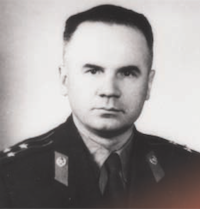
Oleg Penkovsky was a Soviet military intelligence officer who became a double agent for the United States and Britain during the Cold War. His intelligence provided valuable information to the Western powers, but ultimately led to his capture and execution.
10 Interesting Facts about Oleg Penkovsky:
- Oleg Penkovsky was born on April 23, 1919, in Vladikavkaz, Russia.
- He graduated from the Frunze Military Academy in Moscow in 1941 and was later assigned to the Soviet military intelligence agency.
- In the early 1960s, Penkovsky secretly began working with MI6 and the CIA, passing on classified information about Soviet military capabilities.
- The information he provided included details on Soviet missile installations in Cuba during the Cuban Missile Crisis, as well as intelligence on Soviet military technology and plans for a nuclear strike against NATO.
- Penkovsky used the codename “Hero” and communicated with his handlers using a dead letter box system.
- He also smuggled out microfilm in a toothpaste tube and in packages of tea.
- Penkovsky’s double agent work was uncovered in 1962 and he was arrested by the KGB.
- He was tried and convicted of high treason in a secret trial in 1963 and was executed by firing squad on May 16 of that year.
- Penkovsky’s information is credited with providing the West with crucial intelligence during the Cold War, and is believed to have played a role in preventing a nuclear war.
- His story was the basis for the book “The Penkovsky Papers” by British journalist Frank Gibney.
Concluding Statement:
Oleg Penkovsky was a brave and daring spy who risked everything to provide vital information to the Western powers during the Cold War. His ultimate sacrifice was a tragedy, but his legacy lives on as an example of courage and loyalty to the cause of freedom.
9. Sydney Reilly
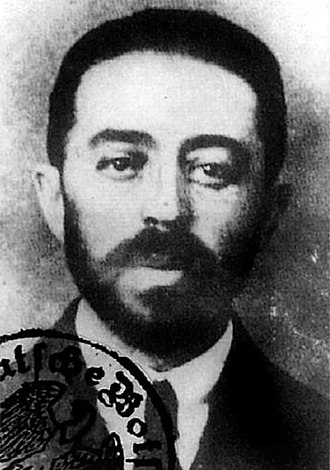
Sidney Reilly, often referred to as the “Ace of Spies,” was a Russian-born adventurer and master spy who operated in the early 20th century. Reilly’s life was shrouded in secrecy and intrigue, and he remains one of the most enigmatic figures in the history of espionage. His daring exploits, intelligence-gathering skills, and ability to navigate the treacherous world of international espionage have made him a legend in the annals of spycraft.
10 Interesting Facts about Sidney Reilly:
- Birth and Background: Sidney Reilly was born as Sigmund Rosenblum in Odessa, Russia (now Ukraine) in 1873. He later adopted various aliases, making it challenging to trace his true origins.
- Early Life: Reilly’s early life is shrouded in mystery, but it is believed that he may have been involved in revolutionary activities in Russia before becoming a spy.
- British Citizenship: Reilly eventually moved to Britain and acquired British citizenship, which allowed him to work as a double agent during World War I.
- Military Service: He joined the British Army during World War I and served as a British officer while simultaneously working for several intelligence agencies.
- Master of Disguise: Reilly was known for his exceptional skills in disguise, allowing him to infiltrate various organizations and gather vital intelligence.
- Espionage Work: He conducted espionage operations in various parts of the world, including Russia, Europe, and the Middle East. He played a crucial role in destabilizing the Bolshevik regime during the Russian Revolution.
- Adventures in Russia: Reilly’s adventures in Russia included daring escapes, espionage missions, and close encounters with Bolshevik authorities. He once infiltrated Moscow dressed as a Cheka officer.
- Failed Mission: Reilly attempted to overthrow the Soviet government in 1925 in an operation known as the “Trust” affair. However, the mission failed, and his fate remains uncertain.
- Disappearance and Death: Sidney Reilly disappeared in 1925, and his fate is still a subject of speculation. Some believe he was executed by the Soviet authorities, while others think he may have lived out his life in obscurity.
- Legacy: Sidney Reilly’s life and exploits continue to captivate espionage enthusiasts, and his character has been the basis for novels, films, and television series.
Conclusion:
Sidney Reilly’s life was a complex and often mystifying tale of espionage and adventure. His ability to navigate the dangerous world of international espionage, coupled with his penchant for disguise and daring escapades, made him a legendary figure in the annals of spycraft. While the circumstances of his disappearance and death remain shrouded in mystery, his legacy as the “Ace of Spies” endures as a testament to his remarkable contributions to the world of intelligence and covert operations. Sidney Reilly’s enigmatic life continues to inspire fascination and intrigue, making him one of the most iconic figures in the history of espionage.
8. Jonathan Pollard
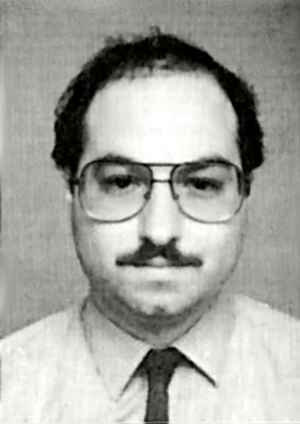
Jonathan Pollard is a former US naval intelligence analyst who was convicted of spying for Israel. His actions have been a subject of controversy and debate for decades.
10 Interesting Facts about Jonathan Pollard:
- Pollard was born in Texas in 1954 and grew up in Indiana.
- He attended Stanford University but dropped out after two years.
- In 1979, he applied for a job with the US Navy and was eventually assigned to the Naval Intelligence Support Center in Suitland, Maryland.
- Pollard began spying for Israel in 1984, providing them with classified documents about US military and intelligence operations.
- He was arrested in 1985 and sentenced to life in prison.
- Israel initially denied any involvement in Pollard’s spying, but later admitted to recruiting him as a spy.
- Pollard’s sentence has been a subject of controversy, with some arguing that it was too harsh and others arguing that it was justified given the severity of his crimes.
- He was granted parole in 2015 after serving 30 years in prison.
- Pollard was required to wear an electronic ankle monitor and obey a curfew as a condition of his parole.
- He renounced his US citizenship in 1995 and moved to Israel, where he was granted citizenship.
Concluding Statement:
Jonathan Pollard’s actions as a spy for Israel continue to be a source of controversy and debate. Despite his release from prison, his story serves as a reminder of the risks and consequences of espionage.
7. Anna Chapman

Anna Chapman was a Russian intelligence agent who gained notoriety for her involvement in a spy ring in the United States in 2010. Her striking looks and glamorous image made her a media sensation, but also landed her in jail.
10 Interesting Facts about Anna Chapman:
- Anna Chapman was born in Volgograd, Russia in 1982.
- She holds a degree in economics from Moscow University and was a successful entrepreneur before becoming a spy.
- Chapman was married to a British man and lived in London for several years before moving to the United States.
- She became a naturalized citizen of the United States in 2002.
- Chapman was arrested in New York City in 2010 along with nine other Russian spies.
- Her spy activities included using high-tech communications and codes, money laundering, and recruiting other spies.
- Chapman was deported to Russia in a prisoner exchange and received a hero’s welcome upon her return.
- She has since become a celebrity in Russia, hosting a television show and making public appearances.
- Chapman is also known for her entrepreneurial endeavors, including a line of designer handbags and a Bitcoin-inspired startup.
- She has been described as a femme fatale and a modern-day Mata Hari.
Concluding Statement:
Anna Chapman’s story is one of intrigue and glamour, but also of deception and betrayal. While her time as a spy may have been short-lived, her legacy as a media personality and entrepreneur continues to capture the public’s imagination.
6. Klaus Fuchs
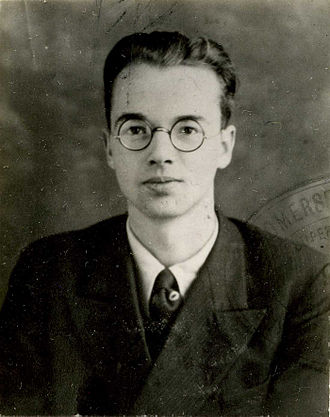
Klaus Fuchs was a German-born physicist who became a notorious spy for the Soviet Union during the Cold War, providing them with vital information about nuclear weapons.
10 interesting facts about Klaus Fuchs:
- Fuchs was born in Rüsselsheim, Germany in 1911 and studied mathematics and physics at the University of Leipzig.
- He fled Nazi Germany for the UK in 1933 and began working as a theoretical physicist at the University of Bristol.
- During World War II, Fuchs worked on the development of the atomic bomb as part of the Manhattan Project in the US.
- In 1949, he was arrested by British intelligence and confessed to passing classified information to the Soviet Union for several years.
- Fuchs was sentenced to 14 years in prison for espionage and stripped of his British citizenship.
- He was released after serving only nine years and moved to East Germany where he resumed his scientific work.
- Fuchs received the Lenin Peace Prize, a Soviet Union award for peace advocacy, in 1958.
- He was involved in the development of the first Soviet thermonuclear bomb.
- Fuchs was also a member of the German Communist Party and the Soviet KGB.
- He died in East Germany in 1988, at the age of 76.
Conclusion:
Klaus Fuchs was a complex and enigmatic figure, whose work as a physicist and spy shaped the course of world history. His legacy continues to fascinate those interested in the intersection of science, politics, and espionage.
5. Robert Hanssen
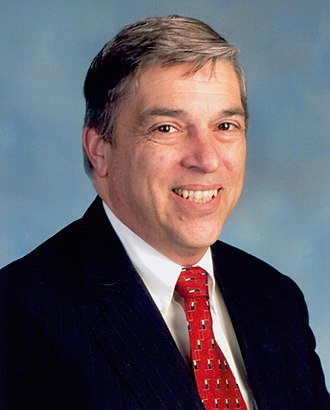
Robert Hanssen was an FBI agent who led a double life as a spy for the Soviet Union and later Russia for over 22 years. He remains one of the most notorious spies in US history, with his actions having had a significant impact on national security.
Interesting Facts about Robert Hanssen:
- Robert Hanssen was born in Chicago in 1944 and grew up in a devout Catholic family.
- After college, he joined the Chicago Police Department before moving on to the FBI in 1976.
- Hanssen was a skilled hacker and used his computer skills to cover up his spying activities.
- He began spying for the Soviet Union in 1979 and provided them with a wealth of information, including details on US nuclear weapons.
- During his time as a spy, Hanssen received over $1.4 million in cash and diamonds from the Soviets.
- His activities were uncovered in 2001 when a former KGB officer named Sergei Tretyakov defected and revealed Hanssen’s identity.
- In addition to being a spy, Hanssen was also a sexual deviant and had an affair with a stripper who he paid with stolen government funds.
- After his arrest, Hanssen agreed to plead guilty in exchange for sparing his wife from prosecution.
- Hanssen was sentenced to life in prison without the possibility of parole, and is currently serving his sentence in a federal prison in Colorado.
- The US government estimated that Hanssen’s spying activities caused damage to national security worth over $1.2 billion.
Conclusion:
Robert Hanssen’s betrayal of his country and colleagues is a testament to the dangers of insider threats and the need for constant vigilance in protecting national security. His case also highlights the psychological complexities of espionage, as even those with strict moral and ethical codes can be lured into acts of treachery. While Hanssen’s actions had a significant impact on US national security, his downfall serves as a reminder that even the most sophisticated spies can be uncovered through diligent investigation and intelligence work.
4. Kim Philby
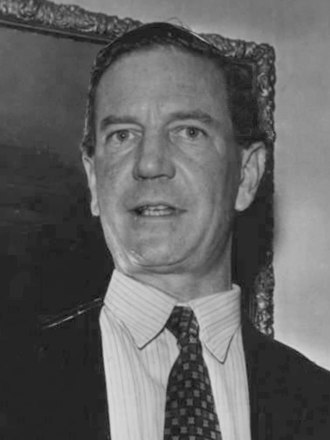
Kim Philby was a British intelligence officer who infiltrated MI6 during World War II, rising through the ranks to become head of counter-espionage. But Philby was also a Soviet spy, passing sensitive information to Moscow for over two decades before defecting to the Soviet Union.
Interesting Facts about Kim Philby:
- Kim Philby was born in 1912 in British India, where his father was a prominent civil servant.
- He attended Trinity College, Cambridge, where he became a member of the infamous Cambridge Five spy ring alongside Guy Burgess and Donald Maclean.
- Philby joined MI6 in 1940, serving in Spain during the Spanish Civil War and later in Turkey and the Middle East.
- His loyalty to the Soviet Union was uncovered in 1963, leading to his defection to the Soviet Union in 1963.
- Philby’s betrayal is believed to have caused significant damage to Western intelligence efforts and may have led to the deaths of multiple agents.
- After fleeing to the Soviet Union, Philby was debriefed by KGB officials and given a comfortable life in Moscow.
- Philby continued to provide advice to Soviet intelligence officials and was celebrated as a hero by the Soviet government.
- Philby’s defection caused a major scandal in the UK and raised questions about the security of intelligence operations.
- His actions inspired numerous spy novels and movies, including John le Carré’s Tinker, Tailor, Soldier, Spy.
- Philby’s legacy continues to be debated by historians, with some viewing him as a traitor while others see him as a victim of his own political beliefs.
Conclusion:
Kim Philby’s story is a complex and fascinating one, highlighting the dangerous world of espionage and the impact that betrayal can have on national security. His actions had far-reaching consequences that are still being felt today, and his legacy as both a traitor and a hero remains a topic of debate among historians and spy enthusiasts alike.
3. Julius and Ethel Rosenberg
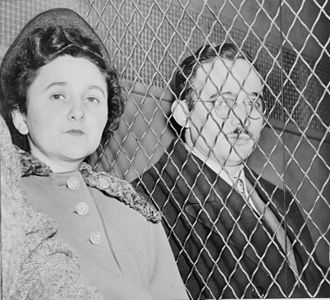
They were a couple accused of espionage, a duo whose fate would be decided by a highly politicized trial that captivated the world. They were Julius and Ethel Rosenberg, and their story is one of love, betrayal, and the high stakes of the Cold War.
Interesting Facts about Julius and Ethel Rosenberg:
- Julius Rosenberg was born in New York City in 1918, while Ethel Rosenberg was born in 1915 in the same city.
- The couple met while attending a Young Communist League meeting in 1936 and were married three years later.
- In the early 1940s, Julius began working as an electrical engineer for the Army Signal Corps, where he had access to highly classified information.
- Julius became involved in a Soviet spy ring and passed classified information to his handlers, including information about the atomic bomb.
- Ethel was also involved in the spy ring and was accused of typing up classified information for Julius to pass on to the Soviets.
- The Rosenbergs were arrested in 1950 and charged with espionage.
- Their trial was highly controversial and was seen by many as a politically motivated attempt to root out Communists.
- The Rosenbergs were found guilty and sentenced to death, despite protests from around the world.
- Their case became a cause célèbre and inspired protests and rallies around the world.
- The Rosenbergs were executed in 1953, becoming the only civilians in US history to be executed for espionage.
Conclusion:
The story of Julius and Ethel Rosenberg is one that still captures the imagination and raises questions about the nature of justice and the power of politics. Their alleged espionage activities and subsequent trial sparked a worldwide debate about the role of government and the rights of citizens. Whether they were guilty or innocent, the Rosenbergs’ story is one that will continue to fascinate and intrigue future generations.
2. Aldrich Ames
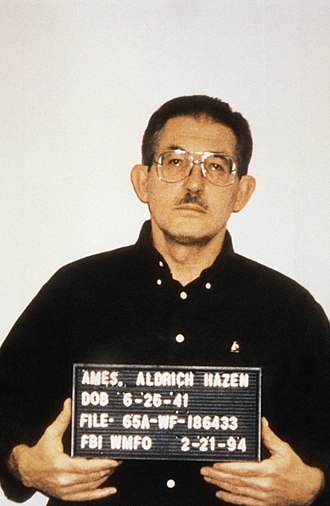
He was a master spy who operated within the highest levels of the US government, wreaking havoc on national security and causing widespread panic. He was Aldrich Ames, and his story is one of intrigue, deception, and the dark side of espionage.
Interesting Facts about Aldrich Ames:
- Aldrich Ames was born in 1941 in River Falls, Wisconsin, and grew up in a middle-class family.
- He attended the University of Chicago and later joined the CIA in 1962, rising quickly through the ranks.
- In 1985, he was approached by the Soviet KGB and offered money in exchange for classified information.
- Ames was motivated by a combination of financial gain and a disillusionment with US foreign policy.
- Over the course of several years, he provided the KGB with highly sensitive intelligence, including the identities of several CIA assets.
- His activities went undetected for years, until a Russian defector provided information that led to his arrest.
- Ames was convicted of espionage in 1994 and sentenced to life in prison without the possibility of parole.
- The damage caused by his espionage activities is estimated to have cost the US intelligence community millions of dollars and compromised national security for years.
- Ames’ betrayal was made all the more shocking by the fact that he was a high-ranking CIA officer and had access to some of the most sensitive information in the US government.
- Despite his actions, Ames remains a somewhat enigmatic figure, with some questioning whether his motives were entirely financial or whether he was also motivated by a desire to expose flaws in US foreign policy.
Conclusion:
Aldrich Ames’ life is a cautionary tale about the dangers of mixing personal gain with loyalty to one’s country. His espionage activities were devastating for national security, and the consequences of his actions continue to be felt to this day. His story serves as a reminder of the immense power wielded by those in positions of authority and the need for constant vigilance against the threat of betrayal.
1. Mata Hari
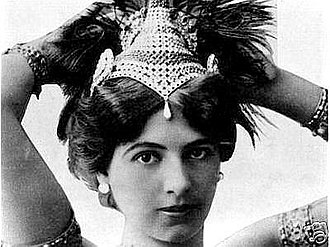
She was a woman of mystery, a seductive dancer who became embroiled in one of the biggest spy scandals of the 20th century. Her name was Mata Hari, and her story is one of intrigue, betrayal, and tragic consequences.
Interesting Facts about Mata Hari:
- Mata Hari was born Margaretha Geertruida Zelle in the Netherlands in 1876.
- She was raised in a wealthy family but fell on hard times after her father went bankrupt and her parents divorced.
- At 18, she answered an ad placed by a Dutch Colonial Army officer looking for a wife and moved to Indonesia, where she learned the local dances that would later make her famous.
- She married the officer, but the marriage was unhappy, and she returned to Europe, where she reinvented herself as an exotic dancer.
- She took the stage name Mata Hari, which means “eye of the day” in Malay, and became a sensation in Paris.
- During World War I, Mata Hari was recruited by both German and French intelligence agencies to spy on the other side.
- Mata Hari’s involvement in espionage remains controversial, and it’s unclear how much information she actually passed along to either side.
- She was arrested by French authorities in 1917 and accused of being a German spy, despite evidence that suggested otherwise.
- Her trial was sensationalized by the media, and she was found guilty and executed by firing squad in October 1917.
- Mata Hari’s legacy has been a subject of fascination for decades, inspiring countless books, movies, and songs.
Conclusion:
Mata Hari was a woman of contradictions, a dancer who became embroiled in a world of espionage and intrigue. Her beauty and charm made her an icon of her time, but her tragic end serves as a warning about the dangers of living life on the edge. Despite the controversy surrounding her life and death, she remains a cultural touchstone, a symbol of a bygone era of glamour and danger.
You can read more top 10 countdowns, or drill into some of our more notorious criminals here. For more research, you can access our bibliography of famous spies.
